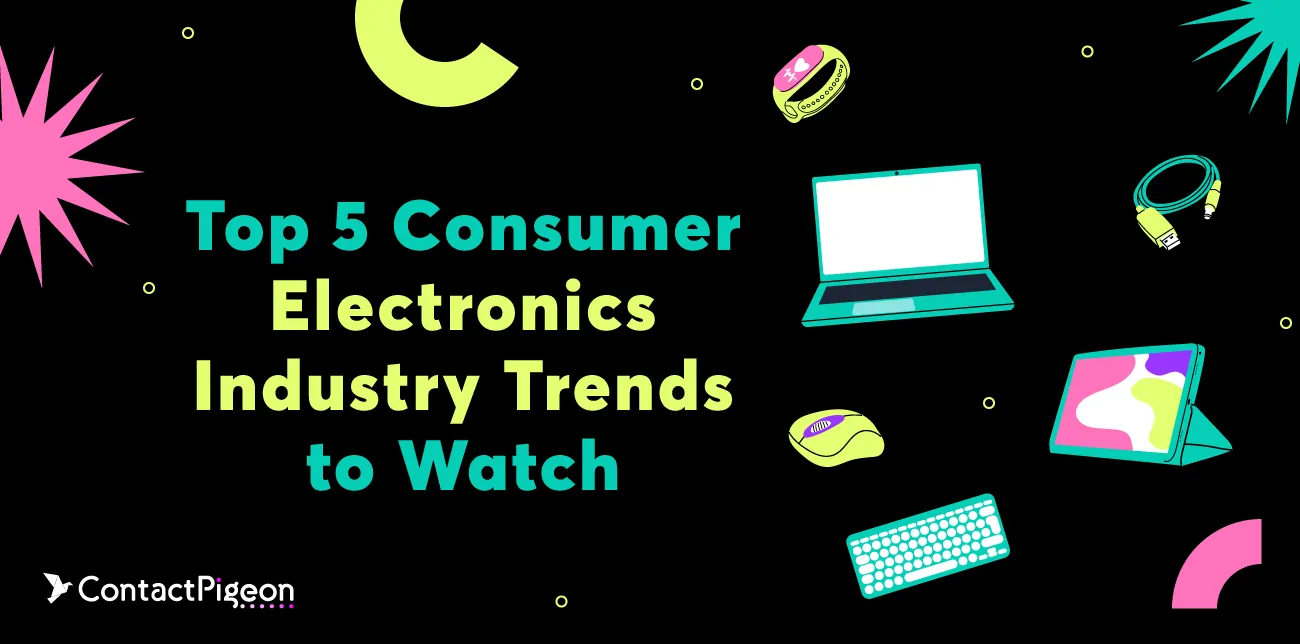The consumer electronics industry is evolving fast, with global IT spending expected to grow by 9.3% in 2025 (deloitte.wsj.com). Staying on top of emerging consumer electronics trends is more important than ever as technology reshapes how we live, shop, and do business. These shifts impact consumers looking for better experiences and companies and eCommerce brands striving to stay ahead. In this article, we’ll break down the top five trends shaping the industry in 2025 and how they’ll influence everything from buying habits to business strategies.
Tech evolution: 25 years of consumer electronics innovations (2000-2025)
Consumer electronics trends have come a long way in just a few decades. In the 2000s, the digital and mobile revolution took off with DVDs, MP3 players, and the rise of e-commerce giants like Amazon and eBay. Mobile phones became widely adopted, but feature phones still ruled the market. By the 2010s, smartphones transformed daily life, streaming services like Netflix and Spotify changed how we consume media, and smart home devices like Alexa and Google Home introduced a new level of connectivity.
The 2020s brought AI-powered automation, a stronger focus on sustainability, and the expansion of 5G, fueling innovations like IoT and smart cities. Now, in 2025, AI-driven devices, extended reality (AR/VR), and eco-conscious, modular technology are taking center stage. This rapid evolution has set the stage for the top five consumer electronic trends that will shape the future—let’s explore what’s next.
Trend #1: AI-integrated devices – How smart tech is taking over in 2025
By 2025, over 60% of households in developed markets are expected to use at least one AI-driven device (ICDREX.COM). Consumer electronics trends are being shaped by AI, making technology more intuitive, personalized, and seamlessly integrated into daily life. From smart assistants that anticipate needs to AI-powered appliances that optimize energy use, AI is redefining convenience and efficiency in everyday tech.
AI in action: How smart tech is transforming electronics
- Smart Assistants & AI-Powered Home Devices
- AI in Personal Devices (Wearables, Smartphones, Laptops)
- AI-Powered Personalization (E-Commerce, Content & Smart Shopping)
- AI in Autonomous & Smart Vehicles
Why AI-powered devices are more than just a trend
For consumers
- More personalized, efficient, and intuitive technology.
- AI makes everyday interactions faster and more convenient (predictive features, automation).
For businesses & retailers
- AI is reshaping customer engagement & eCommerce strategies.
- Companies need to invest in AI-powered personalization & automation to stay competitive.
What’s next? The future of AI in consumer tech
- AI is evolving from reactive to predictive – devices will anticipate user needs before commands are given.
- AI + 5G + IoT will create an interconnected smart ecosystem (fully automated homes, AI-driven healthcare).
- Ethical concerns? Data privacy & AI bias issues will drive regulations & responsible AI development.
Watch how AI is revolutionizing consumer electronics trends at CES 2025! Discover the latest AI-powered gadgets shaping the future of technology.
Trend #2: 5G & IoT connectivity are reshaping smart tech
By 2025, 5G networks are projected to cover one-third of the global population, connecting up to 1.2 billion devices (GSMA.COM). This widespread adoption is revolutionizing consumer electronics trends by enabling faster data speeds, seamless communication, and enhanced automation. The synergy between 5G and the Internet of Things (IoT) facilitates real-time data exchange among devices, leading to smarter and more responsive technology ecosystems. This trend is crucial as it empowers consumers with instantaneous access to information and services, while businesses can leverage these advancements for improved operational efficiency and innovative customer experiences.
5G & IoT in action: Real-world use cases that will change everything
Smart homes & IoT-enabled devices
- Voice assistants, security systems, & automated appliances (e.g., Amazon Alexa, Google Nest).
- AI-powered refrigerators, robotic vacuums, and real-time energy monitoring systems.
Wearable technology & health monitoring
- 5G-powered smartwatches, fitness trackers, and biometric wearables (e.g., Apple Watch, Fitbit).
- Remote patient monitoring & predictive health analytics powered by real-time data.
Autonomous & connected vehicles
- 5G-enabled cars will communicate with smart roads, traffic signals, and other vehicles.
- Examples: Tesla’s AI-driven navigation & Waymo’s 5G-powered self-driving taxis.
Streaming, gaming & digital entertainment
- 5G eliminates lag for cloud gaming & 8K video streaming (e.g., NVIDIA GeForce Now, PlayStation Cloud Gaming).
- AR/VR experiences will be smoother & more interactive.
How 5G & IoT will transform daily life & business strategy
For consumers
- Seamless, lag-free experiences (smart homes, wearables, self-driving cars).
- Hyper-personalization – devices will anticipate user needs in real time.
For businesses
- Retailers & brands must optimize for 5G-enabled eCommerce (AR shopping, real-time customer support).
- Manufacturers must invest in IoT-powered smart products to stay competitive.
The road ahead: Challenges & innovations in 5G & IoT
Challenges
- Security & privacy risks: More connected devices mean higher risks of data breaches.
- Infrastructure limitations: Some regions still lack full 5G deployment.
- High cost of adoption: IoT-enabled devices & 5G tech are expensive for manufacturers & consumers.
Future outlook
- 6G development already in progress – Promising 100x faster speeds & lower latency.
- AI & 5G convergence – AI will optimize network efficiency & automate IoT interactions.
- Smart cities powered by 5G – IoT-driven infrastructure will revolutionize urban planning, transportation, and public services.
5G is changing the game for IoT devices! Find out how ultra-fast connectivity is making smart homes, wearables, and autonomous vehicles more powerful than ever.
Learn the essential factors driving digital transformation in retail by 2025 here.
Trend #3: Sustainability & right-to-repair in 2025 – The eco-tech revolution
In 2025, sustainability and right-to-repair policies are transforming the consumer electronics trends as eco-conscious consumers demand more environmentally friendly products. With rising climate concerns and stricter regulations, companies are under increasing pressure to reduce electronic waste and design products that are easier to repair and recycle. Consumers are opting for brands that prioritize sustainability, driving a shift toward energy-efficient devices and modular designs. This shift is reshaping the industry as businesses align their strategies with environmental and social responsibility.
Eco-friendly electronics: How sustainability is driving innovation
Eco-friendly materials & energy efficiency
- Tech companies are shifting to recycled plastics, biodegradable materials, and lower-energy consumption devices.
- Example: Apple & Dell are using 100% recycled aluminum in laptops and reducing carbon footprints.
Right-to-repair: Giving consumers more control
- New regulations in the EU and the US force companies to provide repair guides & spare parts.
- Example: Fairphone & Framework laptops offer modular, easy-to-repair devices.
E-waste reduction & circular economy
- Electronics waste is a growing crisis—companies must design for longevity & recyclability.
- Example: Google & Samsung offer trade-in & recycling programs for old devices.
Sustainable packaging & carbon-neutral initiatives
- Brands are eliminating plastic packaging, using plant-based inks, and reducing supply chain emissions.
- Example: Sony & Microsoft now ship devices in 100% recyclable packaging.
Sustainability in tech: Why it’s a game-changer
For consumers
- Longer-lasting, repairable products = cost savings.
- Less e-waste = environmentally responsible choices.
For businesses
- Sustainability = a competitive advantage (attracting eco-conscious consumers).
- Right-to-repair laws will force redesign products for durability & modularity.
Fix it, don’t replace it: The future of sustainable gadgets
- Stronger regulations—Governments will enforce stricter sustainability laws.
- Mainstream repairability—Modular tech will expand beyond niche brands like Fairphone.
- Consumer awareness grows—Sustainability will be a deciding factor in tech purchases
As consumer electronics companies pivot towards sustainable tech and right-to-repair policies, ContactPigeon’s marketing automation can help brands communicate their eco-friendly initiatives and engage conscious consumers with personalized content, ultimately driving loyalty and sales. Communicate your sustainability initiatives effectively—let ContactPigeon help you connect with eco-conscious consumers. Start today!
Sustainability meets innovation! Explore how AI-driven devices are not only smarter but also more eco-friendly here.
Trend#4: Extended reality – How AR, VR & MR are revolutionizing tech

In 2025, the Extended Reality (XR) market, which includes AR, VR, and MR, is expected to surpass $300 billion, with applications expanding across industries like gaming, education, healthcare, and retail. XR is no longer just an experimental technology; it’s becoming a core part of how consumers interact with digital experiences. From virtual shopping to immersive learning environments, XR transforms how we work, play, and engage with content. This shift is reshaping the tech landscape, making XR a driving force in the next generation of consumer electronics.
From gaming to shopping: The many faces of XR tech
AR in shopping & retail
- Virtual try-ons & smart mirrors for fashion and beauty (e.g., Sephora, IKEA Place).
- Example: AR-powered apps allow users to see how furniture fits in their home before buying.
VR & mixed reality in gaming & entertainment
- Next-gen VR headsets like Meta Quest 3 & Apple Vision Pro are making virtual experiences ultra-realistic.
- Example: VR concerts, live sports streaming, and interactive storytelling in gaming.
AR & VR in fitness & wellness
- Immersive workout experiences (e.g., VR boxing, interactive Peloton-style fitness).
- Example: Apps like Supernatural and FitXR use VR to make workouts more engaging & effective.
XR in remote work & education
- Virtual offices & 3D collaboration spaces—people meet & work inside AR/VR-powered virtual spaces.
- Example: Microsoft Mesh and Meta Horizon Workrooms enable teams to collaborate remotely in immersive environments.
Why AR/VR is no longer just for gamers
For consumers
- More immersive, interactive experiences in gaming, shopping, and social media.
- Blurring the line between physical and digital worlds (e.g., AR-enhanced travel guides).
For businesses
- Retailers must optimize for AR-powered shopping & interactive customer experiences.
- Brands investing in XR will gain a competitive edge in gaming, eCommerce, and digital collaboration.
Beyond VR headsets: The next phase of extended reality
- Lighter, more affordable AR/VR headsets—Apple & Meta are already working on next-gen mixed reality glasses.
- AR-powered contact lenses & holographic interfaces—the ultimate step toward true immersive computing.
- Social Media & XR Integration—Meta (Facebook) & TikTok are heavily investing in XR-powered interactions.
Step into the future with AR & VR! Watch how AI at the edge is making extended reality experiences more immersive and interactive.
Τrend #5: Foldable & modular devices – Fold it, fix it, upgrade it
By 2025, foldable smartphones and modular devices will be transforming the way we use technology. These innovations offer greater flexibility, durability, and personalization. Foldable devices maximize screen space without increasing pocket size, while modular gadgets allow easy repairs and upgrades, reducing electronic waste. As consumers demand more adaptable and eco-friendly tech, foldable and modular devices are shaping the future of consumer electronics.
Why foldable & modular devices are the future of smart tech
The rise of foldable smartphones & laptops
- Flexible display technology is improving durability & usability (e.g., Samsung Galaxy Z Fold, Lenovo foldable laptops).
- Example: Users can switch between phone and tablet mode on foldable devices.
Modular devices & right-to-repair movement
- Consumers want devices they can upgrade, repair, and customize.
- Example: Fairphone & Framework laptops let users swap out batteries, cameras, and memory modules instead of buying a new device.
Sustainability & longevity of devices
- Foldable & modular designs reduce e-waste by extending product lifespans.
- Example: Google & Dell are working on modular laptops that last 10+ years with user-replaceable parts.
How tech companies are responding to this demand
- Major brands are investing in R&D for durable foldable screens & repairable tech.
- Example: Apple & Microsoft are rumored to be developing foldable tablets & modular hybrid devices.
Why foldable & modular gadgets will dominate the market
For consumers
- More adaptable, future-proof devices that eliminate the need for frequent upgrades.
- A better return on investment—spend more initially, but keep devices for years.
For businesses
- Retailers & manufacturers must adjust to consumer demand for repairability & customization.
- Companies embracing modular & foldable designs will lead the shift toward sustainable tech.
The future of foldable tech: What’s coming next?
- Stronger, more flexible materials – Tech companies are developing self-healing screens and ultra-durable foldable displays.
- Mainstream adoption of modular technology – Right-to-repair laws will force manufacturers to design upgradable devices.
- Foldable & dual-screen laptops will become standard – Samsung, Lenovo, and Dell are already testing prototypes.
Foldable, modular, and futuristic! See the coolest foldable and modular devices from CES 2025 and how they redefine tech. https://www.wired.com/gallery/ces-2025-photo-gallery-day-1/
Beyond 2025: 5 mind-blowing tech predictions that could change everything

By 2030, AI-driven devices will predict our needs before we even think about them, 6G will enable instant communication across the globe, and brain-computer interfaces could make keyboards and screens obsolete. The fusion of technology and biology will redefine how we interact with the digital world, while sustainability efforts will push for fully recyclable, energy-efficient gadgets. Will the next wave of innovation blur the line between humans and machines, creating a future where technology feels like an extension of ourselves?
Bold predictions for 2026 and beyond
- 6G & hyperconnectivity – 6G will enable ultra-fast, seamless global communication, revolutionizing IoT, automation, and smart cities
- AI evolves into emotional & autonomous intelligence – AI will transition from reactive to proactive, making human-like decisions and understanding emotions for more intuitive interactions.
- The shift to holographic & neural interfaces – Holographic projections and AR contact lenses will replace screens, creating a more natural and immersive digital experience.
- Self-healing & sustainable tech becomes the norm – Graphene, biodegradable materials, and modular design will lead to longer-lasting, eco-friendly devices that repair themselves.
- The rise of fully immersive virtual worlds – The Metaverse will expand beyond gaming into everyday work, education, and social interactions, blurring the line between virtual and physical reality.
The future of consumer tech
As consumer electronics trends evolve at lightning speed, businesses must rethink how they engage with tech-savvy, experience-driven consumers. From AI-powered personalization to AR shopping and sustainability-focused products, brands that adapt will thrive in this new era. Retailers and eCommerce brands must embrace innovation, leveraging data, automation, and omnichannel strategies to stay ahead.
ContactPigeon helps future-proof your marketing with AI-driven automation, personalized campaigns, and real-time customer insights. Get your demo here!




